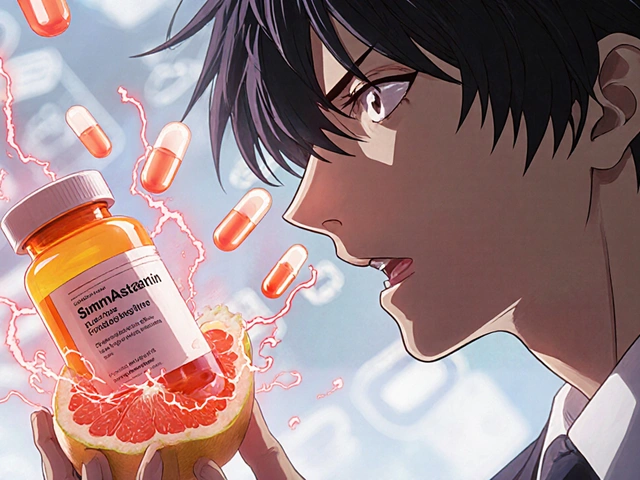Statins and Grapefruit Interaction Checker
Check Your Interaction Risk
Enter your statin type and grapefruit consumption to see if they interact dangerously
When you're taking a statin to lower your cholesterol, you probably don't think about your morning glass of grapefruit juice. But that small habit could be putting you at serious risk. Grapefruit doesn't just taste tangy-it can turn your statin into a dangerous overdose. This isn't a myth or a warning on a label you skimmed over. It's a well-documented, life-threatening interaction that affects millions of people worldwide.
Why Grapefruit Changes How Statins Work
Grapefruit contains chemicals called furanocoumarins. These aren't sugar, vitamin C, or fiber-they're potent blockers of an enzyme in your gut called CYP3A4. This enzyme normally breaks down certain medications before they enter your bloodstream. When grapefruit shuts it down, your body absorbs way more of the drug than it should. For statins like simvastatin, lovastatin, and atorvastatin, this means blood levels can jump by up to 16 times higher than normal. That's not a little bump-it's the equivalent of taking five pills instead of one. The effect isn't temporary. Once furanocoumarins disable CYP3A4, the enzyme stays broken for about three days. Even if you take your statin at night and drink grapefruit juice in the morning, you're still at risk.Which Statins Are Safe? Which Aren't?
Not all statins react the same way. The risk depends entirely on how your body processes them.- High risk: Simvastatin (Zocor), lovastatin (Mevacor), and atorvastatin (Lipitor). These are metabolized almost entirely by CYP3A4. Grapefruit can turn safe doses into toxic ones.
- Low to no risk: Pravastatin (Pravachol), rosuvastatin (Crestor), fluvastatin (Lescol), and pitavastatin (Livalo). These use different metabolic pathways and don't interact meaningfully with grapefruit.
The Real Danger: Muscle Damage and Kidney Failure
The most feared side effect isn't just muscle aches. It's rhabdomyolysis-a condition where muscle tissue breaks down so badly that it floods your bloodstream with toxic proteins. The main culprit? Myoglobin. When your kidneys try to filter it out, they get overwhelmed. This can lead to acute kidney failure, dialysis, or even death. A documented case from 2022 involved a 40-year-old woman who ate grapefruit daily for 10 days while taking simvastatin. She developed severe muscle pain and dark, tea-colored urine. By the time she got to the hospital, her creatine kinase (CK) levels were 20 times above normal. She spent five days in the ICU. She didn’t have a history of exercise, trauma, or other risk factors. Only grapefruit and simvastatin were the triggers. Rhabdomyolysis is rare-about 1 in 10,000 statin users per year. But with grapefruit, that risk can jump 10 to 20 times higher. Muscle pain (myalgia) is far more common. Up to 10% of people on high-risk statins who consume grapefruit report unexplained soreness, weakness, or cramping. Don’t ignore it. It’s your body’s warning sign.
It’s Not Just Juice-It’s the Whole Fruit
Many people think they’re safe if they avoid grapefruit juice. They’re wrong. The furanocoumarins are in the pulp, peel, and membranes-not just the liquid. Eating half a grapefruit has the same effect as drinking a glass of juice. Even grapefruit-flavored sodas, candies, or supplements can contain enough of these compounds to cause problems. And it’s not just grapefruit. Seville oranges (used in traditional marmalade) and pomelos have the same chemicals. Regular oranges, lemons, limes, and tangerines? Safe. No interaction. You can keep those.What Should You Do If You’re on a Statin?
Step one: Know which statin you’re taking. Check your prescription bottle or ask your pharmacist. If it’s simvastatin or lovastatin, stop grapefruit completely. No exceptions. If you're on atorvastatin and you love grapefruit, talk to your doctor. Switching to rosuvastatin or pravastatin is often the safest move. These work just as well for lowering cholesterol, without the grapefruit risk. You don’t have to give up your heart health to enjoy citrus. If you’ve been eating grapefruit regularly and now have unexplained muscle pain, weakness, or dark urine, call your doctor immediately. Don’t wait. Don’t assume it’s just from working out. Your statin could be silently damaging your muscles.




Hannah Magera
November 29, 2025 at 05:52So if you're on rosuvastatin, you can still have grapefruit? That's a huge relief. I've been avoiding citrus for years thinking it was all bad. My pharmacist never mentioned the difference between statins. Thanks for clarifying this so clearly.
Denise Wiley
November 30, 2025 at 04:46I used to drink grapefruit juice every morning with my simvastatin. I had no idea I was risking muscle damage. I switched to pravastatin last month and now I eat grapefruit like it's going out of style. My legs don't ache anymore. Don't be like me - find out which statin you're on and act now.
Austin Simko
November 30, 2025 at 08:26They're hiding the truth. The FDA knows grapefruit isn't the real problem - it's the pharmaceutical companies pushing these drugs. They don't want you to know you can lower cholesterol naturally.
Skye Hamilton
December 1, 2025 at 21:06grapefruit is just a scapegoat… the real villain is capitalism… and also maybe the FDA… or is it the agro-industrial complex… i mean… have you ever tasted a real grapefruit? it’s like liquid betrayal
Nicola Mari
December 3, 2025 at 00:38It's irresponsible to write an article like this without emphasizing that statins themselves are overprescribed. Millions of people take them for borderline cholesterol levels while ignoring diet, exercise, and stress. You're scaring people about grapefruit instead of asking why they're on statins in the first place.
George Hook
December 4, 2025 at 23:17There's a lot here that's accurate, but I want to add one thing: even if you're on a "safe" statin like pravastatin, if you're also taking other meds - like certain blood pressure pills or immunosuppressants - grapefruit can still interfere. It's not just about statins. The CYP3A4 enzyme is involved in metabolizing over 50% of commonly prescribed drugs. So even if your cholesterol med is fine, check everything else on your list. Talk to your pharmacist. They're the unsung heroes of medication safety.
Maria Romina Aguilar
December 6, 2025 at 14:03But… what if… you… only… eat… half… a… grapefruit… once… a… week…? I mean… surely… the enzyme… recovers…? And… isn't… there… a… threshold…? I've read… some… papers… that… suggest… minimal… exposure… might… be… tolerable…? I'm… just… asking…
Olivia Gracelynn Starsmith
December 7, 2025 at 14:54Thank you for writing this. I'm a nurse and I see patients every week who don't realize grapefruit is dangerous with their meds. Most think it's just a "maybe" or "some juices" - not a full stop. Please, if you're on a statin, ask your pharmacist. Don't Google it. Don't assume. Ask. It's that simple.
Sam txf
December 9, 2025 at 01:57Let’s be real - if you’re eating grapefruit with your statin and you’re not in the ICU, you’re just lucky. Not smart. My uncle took simvastatin for 8 years with grapefruit every morning. He didn’t have rhabdo. He had a heart attack at 52. Coincidence? Nah. He thought he was bulletproof. He wasn’t. You’re not either.
Evelyn Shaller-Auslander
December 9, 2025 at 15:21Wait so lemon is safe? I just switched to lemon water in the morning. Good to know. I was scared to drink anything citrusy.
Katrina Sofiya
December 10, 2025 at 02:03This is such an important post. I’ve been on rosuvastatin for 5 years and I still eat grapefruit. I feel so much better knowing I didn’t have to give it up. Thank you for the clear breakdown - this could literally save lives. Please share this with everyone you know on statins.
kaushik dutta
December 11, 2025 at 03:06As an Indian cardiologist trained in both Western and Ayurvedic medicine, I’ve seen patients on simvastatin consume nariyal (coconut) water thinking it’s "natural" and safe - but grapefruit is the real issue. The cultural myth that "natural equals harmless" is deadly here. The science is unequivocal: CYP3A4 inhibition is non-negotiable. Switch statins. Don’t gamble with your kidneys. Your heart will thank you.
doug schlenker
December 12, 2025 at 13:49I had no idea this was a thing. I’ve been drinking grapefruit juice with my Lipitor for years. I’ve had weird muscle soreness but thought it was from the gym. I just called my doctor and we’re switching me to pravastatin next week. I’m so glad I read this. Thank you for the clarity - I feel less scared now that I know what to do.
jaya sreeraagam
December 14, 2025 at 13:16As someone who grew up in India where citrus is part of daily life, I never knew grapefruit could be dangerous. My aunt took simvastatin and drank grapefruit juice daily for 3 years - she never had symptoms, so I thought it was just fear-mongering. But after reading this, I checked her prescription - she was switched to rosuvastatin last year. I’m sharing this with my entire family. Knowledge is protection.
Brandon Trevino
December 15, 2025 at 11:24The data is unequivocal. Furanocoumarins inhibit CYP3A4 with near-complete bioavailability in the duodenum. The pharmacokinetic profile of simvastatin shows a 16-fold increase in AUC with grapefruit co-ingestion. The FDA’s pharmacovigilance database contains over 1,200 adverse event reports correlating grapefruit with rhabdomyolysis in statin users. This is not anecdotal. It is evidence-based medicine. If you are not following these guidelines, you are not a patient - you are a liability.